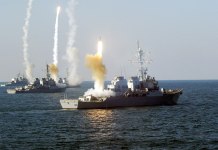Japan has released its Defense of Japan 2025 white paper, outlining growing threats from a tightening bloc of authoritarian powers—China, Russia, and North Korea—sometimes referred to as ‘CRINK’ nations.
The report, approved by Prime Minister Shigeru Ishiba’s cabinet, warns of a rapidly deteriorating regional security environment driven by intensifying military coordination among these nations.
At the heart of the report is a blunt assessment of China, which it labels the “greatest strategic challenge” to Japan.
The paper warns that Beijing’s expanding military footprint, aggressive maritime behavior, and deepening ties with other authoritarian regimes could “seriously impact” Japan’s national security.
The white paper places CRINK—a loosely coordinated bloc that some analysts dub the “Axis of Upheaval”—under intense scrutiny. While not a formal alliance, the growing diplomatic, military, and economic coordination between these four powers is seen as a potent threat to the rules-based international order.
Particularly troubling for Tokyo is the tightening triangle of cooperation between China, Russia, and North Korea, which has shown increased synchronization in military drills, weapons development, and strategic signaling.
Japan’s Defense Minister Gen Nakatani did not mince words: “The existing international order is being seriously challenged, and Japan finds itself in the most severe and complex security environment of the post-war era.”
China: Japan’s “Greatest Strategic Challenge”
Japan has issued its starkest warning yet about China’s expanding military footprint, stating in its white paper that Beijing’s activities now pose a “serious impact” on national security.
The report highlights the first confirmed airspace incursion by a Chinese military aircraft, alongside growing maritime pressure in Japan’s surrounding waters.
The paper reiterates that China’s military ambitions represent an “unprecedented and greatest strategic challenge” to both Japan and the international community. It details Beijing’s mounting presence near Japan, including a Chinese military aircraft entering Japanese airspace in August 2024, and a carrier group sailing between two southern Japanese islands near Taiwan the following month.
For the first time, Japan’s annual threat assessment also raises red flags over China’s “gray zone” tactics—coercive actions that blur the line between peace and open conflict. It points to the expansion of joint operations between the Chinese military and the China Coast Guard, now under the command of the People’s Armed Police (PAP), a paramilitary force closely aligned with the PLA.
“The aim appears to be enhancing operational capabilities to gradually shift the status quo in disputed areas without triggering outright war,” the white paper notes, warning that such tactics—often involving maritime harassment and territorial intimidation—could escalate without warning.
Highlighting the scale of China’s maritime power, the paper reveals that by the end of 2024, the China Coast Guard had 161 large ships—including two 10,000-ton-class patrol vessels, among the largest in the world. These heavily armed vessels are playing a central role in enforcing China’s territorial claims under the gray zone doctrine.
The report also underscores concerns over China’s intensified military exercises near Taiwan, describing them as potential rehearsals for unification operations, including a possible invasion. Japan warns that in a future Taiwan crisis, the China Coast Guard may spearhead a blockade effort, escalating conflict while staying below the threshold of declared war.

Meanwhile, Japan continues to face increasing pressure from Chinese military operations around the disputed Senkaku Islands. The white paper accuses Beijing of unilaterally escalating activities based on its territorial claims, calling them “a source of strong concern.”
“China’s active and assertive military behavior has reached a level that could seriously affect Japan’s security,” the report concludes, marking the first time Tokyo has used such language in a public defense document.
China-Russia Axis: Coordinated Challenge to Indo-Pacific Stability
Japan’s Defense of Japan 2025 white paper warns that deepening military ties between China and Russia pose a serious and evolving threat to regional stability. The growing alliance is seen as a direct challenge to Japan’s security and the broader Indo-Pacific balance.
Beijing and Moscow have ramped up joint military drills, conducting coordinated bomber flights and naval patrols near Japan’s airspace and waters. Tokyo views these as deliberate shows of force aimed at intimidating Japan and undermining the status quo.
Russia, meanwhile, continues aggressive military activity around Japan, particularly in the Northern Territories—Japanese islands still under Russian occupation. Moscow has deployed advanced missiles and fighter jets in the region, while expanding its military infrastructure and staging large-scale exercises in surrounding areas.
Japan also raised concerns about China and Russia’s increasing cooperation in space, cyber, and electromagnetic domains, warning that both nations are enhancing capabilities to disrupt critical infrastructure and communications, both civilian and military.
The report underscores that this China-Russia axis is reshaping the Indo-Pacific’s strategic landscape, with potentially far-reaching consequences for regional security.
North Korea: Accelerated Nuclear & Missile Advancements
Japan’s latest defense white paper highlights North Korea’s accelerated efforts to advance its nuclear weapons and ballistic missile programs, calling them an increasingly grave and immediate threat to national as well as regional security.
North Korea’s military activities are posing an even more grave and imminent threat to Japan’s security than ever before, the white paper noted.
North Korea continues to focus on expanding its arsenal of weapons of mass destruction, launching various types of ballistic missiles with increasing frequency and sophistication. These actions severely undermine regional stability and global non-proliferation efforts, posing a serious challenge to the international community.
With six nuclear tests conducted, Pyongyang is now believed to have the capability to mount nuclear warheads on missiles capable of striking the entire Japanese archipelago, according to the Japanese defense ministry.
In recent years, North Korea has ramped up its missile development, testing ballistic missiles with unpredictable flight paths and so-called “hypersonic” missiles. It is also pursuing nuclear-capable long-range cruise missiles.
Since 2023, Pyongyang has launched solid-fuel intercontinental ballistic missiles (ICBM) like the ‘Hwasong-18’ and ‘Hwasong-19’, along with satellite launches using ballistic missile technology. The regime is now focused on diversifying its delivery systems and enhancing its intelligence, surveillance, and reconnaissance (ISR) capabilities to bolster the effectiveness of its nuclear and missile forces, the white paper notes.
China Pushes Back
Beijing swiftly condemned the white paper. Chinese Foreign Ministry spokesperson Lin Jian expressed “strong dissatisfaction and firm opposition,” accusing Tokyo of exaggerating the so-called “China threat” based on what he called “erroneous perceptions.”
“Japan has adopted a wrong perception of China,” Lin said, asserting that China’s military activities are “legitimate and justified.” He added that Beijing had lodged a formal diplomatic protest, warning Tokyo against misrepresenting China’s intentions.
The Chinese government dismissed the report as an attempt to stir regional tensions, claiming it distorted China’s actions and unfairly framed them. “This kind of hype only undermines trust and stability in the region,” Lin warned.
Japan Boosts Defense Spending, Deepens US Ties
In response to these rising threats, Japan is accelerating its multi-year defense buildup and strengthening ties with the United States and regional allies.
The goal is to make combined US-Japan forces more flexible and better prepared to respond to contingencies, including a potential crisis in Taiwan.
The Financial Times reported that the US is urging Japan and Australia to clarify their roles in the event of a conflict over Taiwan. Elbridge Colby, a former U.S. defense official, has advocated for stronger allied commitments, emphasizing that frank conversations about burden-sharing are crucial to collective security.
Japan’s 2025 defense white paper marks a significant strategic shift. Faced with an increasingly coordinated CRINK bloc, Tokyo is recalibrating its defense posture, warning of serious risks to national and regional stability, while aligning more closely with the United States to deter potential conflict in East Asia, particularly over Taiwan.
- Shubhangi Palve is a defense and aerospace journalist. Before joining the EurAsian Times, she worked for ET Prime. She has over 15 years of extensive experience in the media industry, spanning print, electronic, and online domains.
- Contact the author at shubhapalve (at) gmail.com




